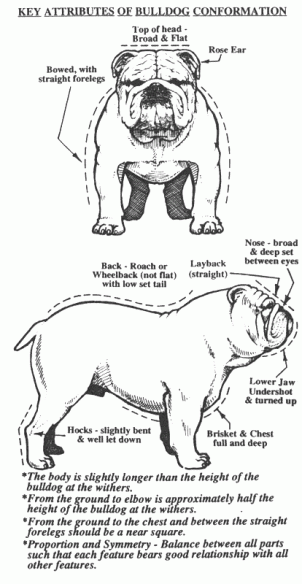Bayside Bulldogs
English Bulldog Breeder

About the Breed
History
The term “bulldog” was first used around 1500 and might have been applied to various ancestors of modern bulldog breeds. In the 1600s, bulldogs were used for bull-baiting, a wagering sport popular in the 17th century in which trained bulldogs jumped at a bull lashed to a post, latched onto its snout and attempted to suffocate it. The practice of bull-baiting was banned in England in 1835. After bull-baiting was banned, the breed began to die out (known as the Old English Bulldog) until fans turned to conformation dog shows. The first show to have a class for bulldogs was in Birmingham. Just a few years later, in 1864, a club was organized to enhance the breed. Unfortunately, this group never picked a specific breed standard, and in 1891 the two top bulldogs, King Orry and Dockleaf, were greatly different in appearance. King Orry was reminiscent of the original bulldogs — lighter boned and very athletic. Dockleaf was smaller and heavier set — more like modern bulldogs. Dockleaf was declared the winner that year. Although some argued that the older version of the bulldog (known as the Old English Bulldog) was more fit to perform, the modern version’s looks won over the fans of the breed.
Appearance
The Bulldog is a relatively small but stocky breed, with a compact body and short, sturdy limbs. Their shape results in a waddle-like gait.They are known for their short muzzles and the saggy skin on their faces, creating the apparent “frown” that has become a trademark of the breed. Bulldogs come in a variety of colors and ideally have a smooth, short coat. The size for mature dogs (males) is about 58 pounds and about 45 pounds for mature bitches (females). Though stout, the adult Bulldog measures only about 12-14 inches (30-36 cm) tall at the shoulder.
Temperament
Contrary to classic cartoon parodies and nicknames of the breed, such as ‘Sour-Puss’, that depicted the bulldog as ferocious and wearing a spiked dog collar, the bulldog is not a vicious dog breed and gets along well with humans, including children, and usually other dog breeds. The reputation of being ferocious was true during the days of bull-baiting, but the aggressive tendencies were bred out of them by the time of World War II.
While bulldogs are very friendly and playful, according to bulldoginformation.com, in general, the qualities most often mentioned about English bulldogs are "faithfulness, stubbornness, protectiveness and devotion to loved ones." The intelligence of the bulldog is often questioned. What appears as stubbornness is actually the ability to prioritize. A bulldog won't jump at your command, but evaluate it.
The idea that the bulldog is lazy probably developed because of their exaggerated features.
If a prize were awarded for companionship among dog breeds, the bulldog would win the gold. They will do anything to make you laugh, and they are wonderful with children and the elderly. They are sensitive to your moods; when you are happy they are perky. Part of their charm is that they look tough, but really aren't at all. Most bulldogs are brave and will guard and defend their owner if they are threatened. If you are looking for a full-time body guard, however, it's probably not the right breed for you.
Source: Bulldog Club of America
